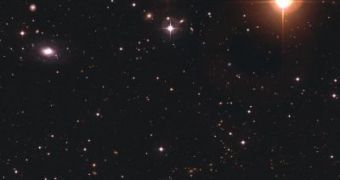The night sky is mostly black and it seems mostly empty. But appearances can be deceiving! This image released by the ESO is taken from a part of the sky from where you wouldn't normally see anything, even with a fairly good telescope. But it isn't empty! They have taken the picture with the Wide-Field Camera on the 2.2m telescope at La Silla (Chile), allowing the camera to stare at the same part of the sky for 64 hours. During this time, the very faint light coming from there gradually accumulated and this image has formed (see picture below). The covered area is five times the size of the full moon and the objects that can be seen here are 100 million times fainter than what the unaided eye can see.
The red giant (visible in the upper right corner of the detail image) is about 8 times fainter than what the unaided eye can see. The 'S'-shaped ensemble of dots, visible in the lower part of the picture, is not an ensemble of stars, but of galaxies! All these dots are in fact about the same size as our own galaxy and each contains billion of stars! Astronomers can realize this by studying the spectral characteristics of each dot (they can decompose the light and see from what wavelengths it is made of). A star has a different spectral characteristic than a galaxy (as a galaxy is made out of many stars, its spectral characteristics is the sum of all spectral characteristics of all the stars).
The photographed area, named Deep 3, was chosen at random from all the "empty" areas that can be observed from the La Silla observatory all over the year. Such "empty" regions provide an unusually clear view towards the distant regions in the Universe and thus open a window towards the earliest cosmic times.
Photo credits: European Southern Observatory

 14 DAY TRIAL //
14 DAY TRIAL // 
